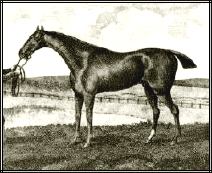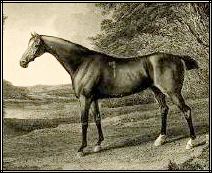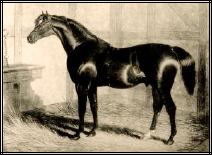|
|
The Dukes of Grafton: The Breeding
 |
|
|
|
The Breeding
Historians of thoroughbred racing and breeding generally credit four eighteenth century stallions as the mainspring of the present day classic thoroughbred--Eclipse, Matchem, Herod and Herod's son, Highflyer (out of a Godolphin Arabian line sire (Blank) mare, Rachel). Late eighteenth century breeders exploited the advantages of crossing the sons of each of these stallions on the daughters of the others, to get the speed and stamina desired for the increasingly popular, and eventually principal markers of racehorse success, the one and one-half mile classics. Although these four horses ran when distance and durability were still primary factors in racing, they all, to a greater or lesser extent, passed on to their progeny an ability to run the shorter distances at speed, and at a younger age.
During this period, broodmares, almost always former racing mares, were increasingly drawn from the ranks of the daughters of these sires, the Eclipse-Herod nick being the most immediately successful and frequently exploited. There were breeders who insisted that Eclipse be seen in the top line, with Herod daughters below, and there were those who insisted the reverse was more successful. Eclipse's owner, Dennis O'Kelley, persisted in bring Herod mares to his stallion and his stallion's sons, he would have "nothing else." Richard Tattersall, owner of Highflyer, sought out Marske mares (generally agreed-upon sire of Eclipse). Two eighteenth-century paddock axioms (see right) were generally adhered to during this period; Snap (Snip-Fox mare), bred by Cuthbert Ruth was a grandson of Flying Childers, who beat another speedy descendant of the Darley Arabian, Marske (sire of Eclipse) twice at Newmarket in 1756.*
|
The notion of identifying and categorizing the tail-female lines of these mares was still far in the future, although it is clear from looking at the patterns of successful late eighteenth century broodmares, that their close-in female relatives, at least, weren't completely ignored when making breeding decisions. Still, the Grafton mares were among the first to be recognized as prepotent in their own right, and a filly from the Julia line was a highly sought commodity, when available, and often not only as a probable successful race mare in her own right, but a source of future excellent racehorses.
The 3rd Duke of Grafton purchased Julia, a Blank-Partner mare, in 1763, from "polite Tommy Panton," son of an established horse breeding family and brother-in-law to the Duke of Ancaster. Bred to Snap by the 3rd Duke, she produced a 1768 filly, Promise, and bred to Herod the following year, she produced the 1769 filly Princess. Retained by Grafton, these two mares in turn produced daughters of great significance to the thoroughbred breed. The female line Julia established is known today as Bruce Lowe's female Family Number 1. After dropping Princess, Julia produced "one of the finest foals ever seen" to the cover of Squirrel in 1770, but it died early. In the winter of 1771 Julia, "owing to great carelessness...got at some withered yew, which poisoned her, and deprived his Grace of one of his most prized brood mares."

Promise, bred to Highflyer when she was 19, produced the filly Prunella, destined to become one of the most significant broodmares in thoroughbred history through both her daughters and her sons. Another daughter of Promise's, Peppermint (1787, by Eclipse), sent two strong mare lines forward, one of which terminated with the mid-nineteenth century brothers, Gunboat and Lifeboat (Sir Hercules), the other leading to the tiny, game and excellent racehorse of the 1880s, The Bard (1883, Petrarch-Magdalene), and the Italian sire Massena (1903, Melanion-Maranine).
Princess was bred to Herod and had the filly Puzzle in 1778, whose daughters and grand-daughters produced classic winners for the Graftons, and whose later descendants led to important sires, Dollar, Speculum and, later down the line, Spearmint, as well as a number of significant broodmares.
|
 | |
Derby winner WAXY (Pot-8-Os - Maria by Herod), purchased in 1807 for the Grafton stud, proved to be the right choice for the Grafton mares.
|
 | | | PENELOPE, Prunella's daughter by Trumpator, Good race mare and unparalleled broodmare, when bred to Waxy she produced three classic winners, and a number of sons and daughters who had a significant impact on the breed. |
| | The 3rd Duke bred some of his mares to the most successful sire son of Eclipse, Pot-8-Os, owned by Lord Grosvenor. But it was the Sir Frederick Poole's son of Pot-8-Os, 1793 Derby winner Waxy, to whom Grafton repeatedly and successfully took his Julia-descended mares. The bay Waxy, whose dam was by Herod, is considered to "...have brought more 'high quality' into English bloodstock than any other single sire."* His head, with its concave profile, reflected his arab antecedents, and was something he passed on to many of his progeny. After patronizing him for years, the 3rd Duke finally purchased the middle-aged stallion for the Grafton stud in 1807 (Waxy died in 1818 at the age of 28).
When Waxy was crossed to the mares from Julia, he got classic winners and a lasting impact on the General Studbook. Both the 3rd and 4th Dukes, also took advantage of the other top stallions of the day standing at other studs, notably Trumpator, Rubens, Walton, and later Selim and Walton's son, Phantom, weaving back into their mares' foals the blood of Eclipse, Herod, Highflyer and Matchem.
Julia's descendants were not the only ones bred at the Grafton stud; the 4th Duke, in particular had classic winners from other mares, and some of these have come forward to today as well. See below for some notes regarding these horses.
*Theodore Cook, A History of the English Turf, V. II, p. 286. It should be noted that William, the Duke of Cumberland bred both Eclipse and Herod.
**Ibid., p. 312. |
Some Other Grafton Horses
The 4th Duke of Grafton periodically branched out to purchase horses not bred at Euston. He was often quoted as saying "Let us find the horse and then we'll talk about the jockey." Although this essay focuses on the Grafton classic winners and their progeny, many other important races were held in the south, and a number of animals bred at Euston, usually, but not always, descended from the Julia mares or their sons, were winners of such races as the Oatlands Stakes, the Garden Stakes, the Beacon Course Two Middle Miles, and others. Horses bred or descended from Prunella daughters sold to other studs were successful in the Albany Stakes (Dardanelles, Sultan-Pawn Junior); the Winchester Cup and Saltram Stakes (Omen, Orville-Whizgig), and many more. |
 | | An intensely bred mix of Herod and Eclipse, Grafton bred stallion, PARTISAN (1811, Walton-Parasol by Pot-8-Os). Partisan was a speedy, successful racehorse for the 4th Duke and retired to the Grafton stud as a stallion, where he became a huge succcess; his progeny are still with us today through sons Gladiator (sent to France) and Venison, and Gladiator's daughter, Queen Mary. Engraving by Clifford after J.F. Herring.
|
| Pedigree of Zeal 1818 | Partisan
1811 | Walton 1799
| Sir Peter
1784 | Highflyer | | Papillon | Arethusa
1792 | Dugannon | | Prophet mare | | Parasol 1800 | Pot-8-Os
1773 | Eclipse | | Sportsmistress | Prunella
1788 | Highflyer | | Promise | | Zaida 1806 | Sir Peter 1784 | Highflyer
1774 | Herod | | Rachel | Papillon
1769 | Snap | | Miss Cleveland | | Alexina 1788 | King Fergus
1775 | Eclipse | | Polly | Lardella
1780 | Young Marske | | Cade mare |
|
| |
Zaida was an 1806 filly purchased by the 4th Duke to breed back to the bloodlines established by Prunella. Zaida was a daughter of Sir Peter (1784, Highflyer-Papillon), out of the mare Alexina 1788 (King Fergus-Lardella), and thus fairly closely related to the stallions to which he bred her.
Bred to Partisan (1811, Walton-Parasol) , she produced the 1818 filly Zeal. Parasol was a Prunella daughter, and Walton a "cobby-looking" horse by Zaida's sire, Sir Peter. At age three Zeal won the 1,000 Guineas. She, in turn was bred by the Duke to Woful, another Grafton-bred stallion (1809, Waxy-Penelope), producing the in-bred filly Arab in 1824, who also won the Duke the 1,000 Guineas, this time in 1827. When bred to Saracen, Zeal produced Alumnus (1833), who won the Newmarket St Leger and the Prendergast Stakes.
In 1820 Zaida foaled the brown filly Zinc, by Woful, one of the 4th Duke's better racing fillies in three decades of good performers. She won the 1,000 Gs and the Oaks, and placed second in the Newmarket Stakes and the Grand Duke Michael Stakes.
Another mare in the 3rd Duke's broodmare band, who was not directly related to Julia, was Drab (1791) by Highflyer, out of Hebe, a grand-daughter of Blank with several strains of Darley Arabian and Godolphin Arabian and a large number of other oriental sires in her pedigree. When the 3rd Duke bred her to Pot-8-Os, she produced Dabchick in 1798, who entered the stud relatively early at the age of 5. She was bred to another of the Herod sire line so favored by the Duke, Buzzard. Buzzard, a "large, coarse horse with lop ears" owned by Lord Egremont of Petworth, was out of a Matchem sire line mare, Misfortune, and was the sire of three famous sons, Castrel (1801), Selim (1802) and Rubens (1805). The result of this breeding, the 1803 filly Vanity, won twelve races for the Dukes prior to being retired to the stud in 1810; her daughter, Catgut, by Juniper or Comus, won the Oaks for the 4th Duke in 1819. It was through Vanity's Grafton-bred daughter, the 1814 chestnut filly Coquette, that this line went forward to Lady Maura, dam of *Galore (1885), and Flocarline, dam of Master Robert by *Mazagan.
|
|

